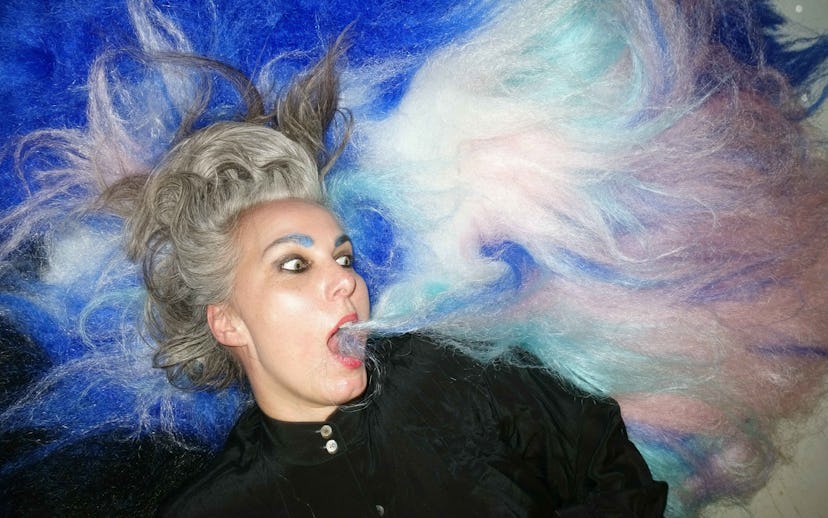
Entertainment
Shoplifter Will Get You High With Just Her Hair
The “Ghostbeast” lives
Hair is personal. Hair is political. Hair is one of the more peculiar mediums to create art in, but New York-based Icelandic artist Shoplifter has masterfully found a means to produce awe-inspiring pieces of work that exist within the intersection of the personal and political. Through real and synthetic hair material, along with a variety of other structural elements and found objects, Shoplifter's work tackles vanity, mythology, and the sublime. It's haunting, surreal, and undoubtedly extraordinary.
This year, she's unveiling a site-specific installation called "Ghostbeast" down at Houston's Day For Night music and arts festival. With The Endless Collective as her collaborator, Shoppy—as she's sometimes known—has taken over a 2,500-square-foot space with projections, hidden fencing, and, yes, hair. Lots of it. "I want people to experience a new form of reality," she tells us a few days before the fest opens, "to elevate their minds through their senses to bring them into 'a vortex of a nebula,' as if they were sleepwalking yet awake!" Trust us: This is one hairy situation you want to be in. Find out why in our exclusive interview below.
How have you challenged yourself for your Day For Night show?
I'm making an installation titled “Ghostbeast,” and it is made up of tangled fences, synthetic white hair, sound, and projection. I am projecting an animation made in collaboration with The Endless Collective, best known for their art-driven work in VR and visual effects in films such as Gravity. I haven't used projection before, and that has been the best challenge, along with using more hardware-oriented materials, like the fences that I'm coiling and twisting like fabric to form a more chaotic, organic shape. It really took me out of my comfort zone, and I truly welcomed it. For some years now, I've wanted to work more within digital formats. I am, in essence, a very analog and hands-on type of artist. But now, thanks to one of the DFN curators Alex Czetwetynski, I get to play around with new industrial materials in a space that's an incredible backdrop to that and with the budget to work with animation and sound to create a different visual and emotional experience for the viewer. I'm thrilled!
Can you give us a little insight into why you're making it?
I've been working with hair for a long time now. I'm always looking for ways to expand the ways to use it, as long as it keeps inspiring me. For the "Ghostbeast" project, I wanted to create a fragmented installation that suggests the presence of a moving organism with pulsating energy that the viewer can feel in their chest. I wanted the installation to melt into the building, like a climbing vine or white mold, and since I prefer to work very site-specific, and the space they gave me to work with here in Houston is a giant caged off 2,500-square-foot transparent room, it started to play a big role in the choice of materials to support the skeletal element of the beast.
I'm attaching bundles of hair together in large clusters on tangled metal fencing and on the fenced walls that surround or map out my space in the festival. I have a four-channel audio soundscape that plays in an ongoing sequence that I worked on with the help of Joshua Kessler from Kessler Mastering Boutique. The animation was created with Duncan Ransom from The Endless Collective, and it consists of animated moving fur and other elements that, when projected onto the actual hairy fur, will give the illusion of movement—a breathing, hibernating, psychedelic, fuzzy ghost.
What has this project taught you thus far?
This project has cemented my trust in my own instincts and that following the seemingly chaotic and abstract process works! It has also shown me that I'm capable of taming the most unusual material I've worked with to my needs to represent a more organic shape than just a metal fence.
Due to size and color, many of your projects exist within the intersection between the surreal and the sublime. How does your Day For Night piece reflect that?
The surreal is embedded in the illusion of movement. The projection makes the installation very trippy and psychedelic, but not loud, fast, or eventful—it's more like a dreamscape. The viewer won´t be able to easily map or grasp where the installation begins or ends. A sense of the sublime is for the audience to communicate and if I'm doing it right, I bring out the natural feeling of ecstasy without any synthetics.
What do you hope Day For Night festivalgoers walk away from your exhibit with?
I'm attempting to give people a trip without the drugs—just a natural high!
Considering all this world has been through this past year, art seems more important than ever. What is the value of creating work, such as your own, today?
Bringing about new experiences through multimedia and art is a way to offer an escape into invented realities we so long to nest in "to get away from it all." As is the case with music, movies, and all the creative fields including design, craft, cuisine etc… Creative people collectively contribute great variations to our experience and preconceptions of beauty and ugliness, harmony or chaos with our work. I feed on the arts to survive, to be inspired, to wake up in the morning and face the world and to keep myself sane, and in the end, it's not an escape at all but rather the destination in order to avoid a completely dull existence. I truly believe that when we are happy and content and kinder to others, art has the ability to affect you in such positive ways to inspire kindness and tolerance to our differences. To quote Friedel Horneman from the documentary film The Galapagos Affair: “Paradise is not a place, it's a condition.”